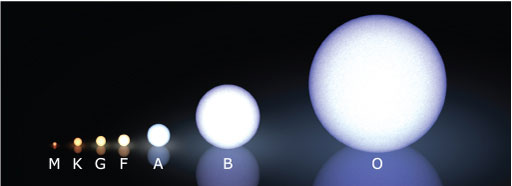2.3 Stars, colour and size
Once the transit of an exoplanet has been spotted, how is the size of the star measured? Most of the time stars are too distant for us to measure their sizes directly – they just appear as points of light in the sky in even the most powerful telescopes. Fortunately though, stars are pretty well-behaved and astronomers have a good understanding of how they work. They can use the measurements of the few stars that are close enough to the Earth to work out what other more distant stars are like.
Stars such as our Sun are part of what astronomers call the ‘main sequence’, a phase in which they spend most of their luminous lifetime. As you saw in Week 1, the properties of main sequence stars follow some simple rules – the largest are very hot stars and blueish in colour, while the smallest are cooler and are reddish in colour. Figure 7 shows the relative sizes and colours of the different types of main sequence star, ranging from the largest, bluest and hottest (‘O stars’) to the smallest, reddest and coolest (‘M stars’). In fact, there’s a whole continuous sequence of star sizes.
Last week you learned that the spectra of stars contain fingerprints of the gases they are made of – the patterns of absorption lines. Stars with similar temperatures tend to have similar patterns in their spectra. So, we can determine which category a star is in from its spectrum. Because of this, it is possible to gauge the size of a star, even if it can’t be measured directly.

